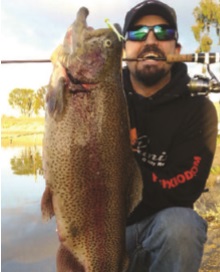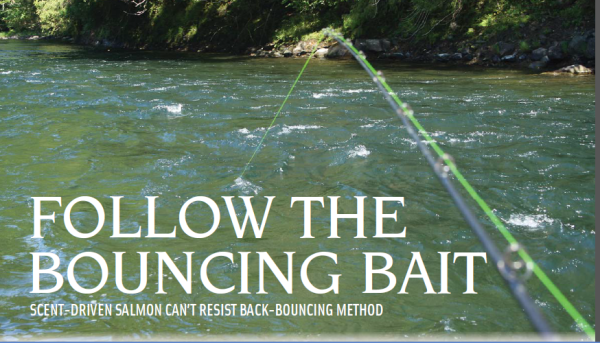RIG THAT JIG
WINTER MEANS GIANT SOCAL TROUT
By Chris Cocoles
Winter trout in Southern California lakes can be massive. Just ask Craig Adkinson, a veteran Orange County-based angler who swears by fishing jig setups this time of year.
Adkinson had a productive opener at the Santa Ana River Lakes in November, landing a 10-pound Mt. Lassen-strain rainbow on chartreuse and white Mijos Minnow jig. He hopes for many more big ?sh to come into 2015. There are no shortage of options for

Southland anglers to dip a line with the prospects of pulling out monster rainbows and browns. Santa Ana River Lakes and Irvine Lake are convenient locations for Adkinson, who lives in the city of Orange. Toward the Inland Empire, try Yucaipa Regional Park and Corona Lake; Adkinson also likes to hit up Jess Ranch Lakes near Hesperia and Lake Poway, northeast of San Diego.
But the common ground of wherever you choose to fish is finding good jig baits. One setup that will help you catch big trout on jigs include a dropshot rig.
“There’s a pencil weight on the bottom with a little loop on top,” Adkinson says of the dropshot presentation. “The little pinch part (atop the weight) is made really simple to where all you do is stick the line through it and it will hold the line in place.”
Several variations on jigs and worms work well: Berkley Power worms, Shaun’s Smokin’ jigs, Sniper Baits, LGE worms, Lip Ripperz are all staples at Southern California lakes.
Some kind of garlic- or roe-flavored scent will add some flavor to the lure, and Adkinson likes to add one more appetizer to his setup.
“If you’re using a crappie jig or a tube jig – whatever you want to call it – one thing for certain is getting some jumbo mealworms, the ones they sell for (anglers who) fish for catfish. If you pin the opposite end of the worm on your jig, that mealworm moves around on there after you throw it out. So a lot of times it’ll get bit when it’s falling.”
The addition of a live worm tipped onto your hook only enhances jigs that already provide natural movement that drives fish crazy.
“They call it a reaction strike that you’re going for. For larger fish, they’re aggressive,” Adkinson says, “and though you’ll see big fish when guys throw out a nightcrawler and the occasional guy who will get lucky and catch a big one on PowerBait, but in schools of fish there are a bunch of little ‘rats.’ But you want to throw a bait big enough so the rats can’t eat it and you won’t get kicked off the lake for catching too many fish too fast.”
The cast you make is only a fraction of the technique needed. How you retrieve your rig back is also crucial to enticing bites.
“When you throw out your jig – whether it’s a dropshot or Carolina rig – if you’re using a spinning rod and reel, take your index finger and put it on the top part where the cork or foam meets the blank of the rod,” Adkinson says.
“Continue to balance the rod to where it’s not moving crazy-style but just move consistently. And at the same time, barely move the handle really slowly. You want to make sure to keep your bait in the strike zone longer and keep it going so it’s shaking in front of the fish’s face.”
When throwing a dropshot rig, Adkinson thinks it’s effective since the weight of the setup will begin to sink toward the bottom but the

dropshot will remain suspended off the rocks. By turning the reel slowly it keeps the bait in the strike zone longer, but at the same time, irritating trout enough that they’ll often react to the presentation.
“But if you’ve thrown it out like 30 times one way and you’re retrieving it slowly and bouncing it and nothing’s happening, that’s when we start throwing it out, jerking it once and then letting it sit there for a second,” he says. “It’s what they call dead-sticking it. If that doesn’t work we’ll do what it’s called speed up and slow down – go super fast like it’s scared and then tone it down for a little bit. Lots of time that gets (trout) to react.”
Adkinson also likes to use a “rattle bobber” with his jigs for early-morning situations.
“That little bobber has little shotgun shell BBs inside, and when you fish it, that thing rattles. So you can have a crappie jig with a (5- to 8-foot leader) and you let that stay on the surface,” Adkinson says. “In the mornings or evenings the fish come up to the surface feeding on baitfish. The bobber keeps the lure up top, and it makes noise.” CS
Editor’s note: Craig Adkinson is the on pro staff for Phenix Rods, Izorline line, Owner Hooks, Skinny Bear jigs, Sea Eagle Boats, Wiley X glasses, Bite-On scents and Cast Mate rod holders, among others.



